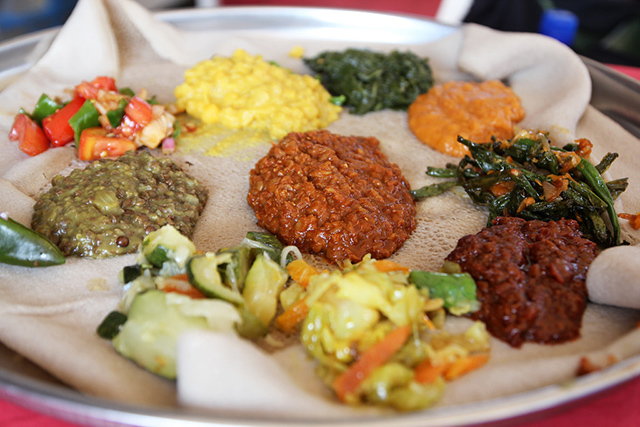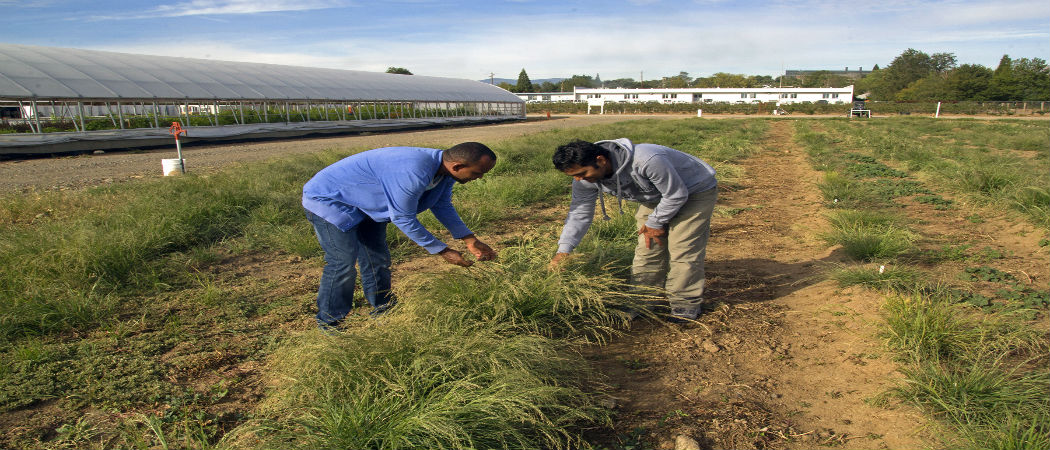
The Ethiopian diet is a fascinating blend of ancient traditions and modern adaptations. A recent study by the Ethiopian Public Health Institute found that 60% of Ethiopians still adhere to traditional dietary patterns. This statistic reminds me of my first encounter with Ethiopian cuisine. I was struck by the unique flavors and communal dining experience, which sparked my curiosity to delve deeper into this rich culinary world.

Source: migrationology.com
Cultural and Historical Foundations
The Ethiopian diet is deeply rooted in the country’s rich history and diverse cultural landscape. Centuries of traditions, religious influences, and agricultural practices have shaped the unique culinary identity of Ethiopia. This diet reflects the country’s geographical diversity, from highland plateaus to lowland plains, each contributing its own flavors and ingredients to the national cuisine.
Ethiopia’s agricultural history dates back to 6000 BCE, with evidence of teff cultivation from 4000 BCE. This long-standing agricultural tradition has been pivotal in shaping the country’s dietary habits. The Aksumite Empire, which flourished from 100-940 CE, played a crucial role in establishing trade routes that introduced new spices and cooking techniques to the region. These historical influences continue to resonate in modern Ethiopian cuisine.
Despite its rich culinary heritage, Ethiopia faces significant nutritional challenges. According to the Global Nutrition Report, Ethiopia has made some progress towards achieving the target for stunting, but 36.8% of children under 5 years of age are still affected, which is higher than the average for the Africa region (30.7%). This statistic underscores the importance of understanding and improving the nutritional aspects of the Ethiopian diet.
The ancient city of Axum, once the capital of the Aksumite Empire, still showcases remnants of elaborate stone stelae and obelisks, testifying to the advanced civilization that contributed to Ethiopia’s rich culinary traditions. These historical sites serve as a tangible link to the past, reminding us of the deep-rooted nature of Ethiopian food culture.
The Role of Teff in Ethiopian Cuisine
Teff, a tiny grain native to Ethiopia, forms the backbone of the country’s diet. It’s used to make injera, the staple flatbread that serves as both food and utensil in Ethiopian meals. Injera’s slightly sour taste and spongy texture make it perfect for scooping up stews and vegetables, embodying the essence of Ethiopian dining.
This remarkable grain is the world’s smallest, measuring just 1/150th the size of a wheat kernel. Despite its diminutive size, teff packs a powerful nutritional punch. Ethiopia produces over 90% of the world’s teff, with annual production exceeding 4 million tons. The cultivation of teff requires specific soil conditions and altitudes between 1,800 and 2,200 meters above sea level, highlighting the unique geographical factors that contribute to Ethiopia’s food culture.
Recent innovations in teff production have caught global attention. A team of researchers has developed a method to create instant teff bread, potentially revolutionizing how this traditional superfood is consumed both in Ethiopia and abroad. This development, highlighted in the article “Hacking traditional Ethiopian superfood to make instant bread” by NoCamels, showcases how ancient grains like teff are being adapted for modern lifestyles while maintaining their nutritional benefits.
Source: Adobe Stock
Nutritional Profile of Teff
Teff is exceptionally nutritious, being high in protein, fiber, and essential minerals like iron and calcium. Its nutritional density contributes significantly to the overall health of Ethiopians. I’ve found that incorporating teff into my diet has improved my energy levels and digestive health.
The nutritional breakdown of teff is impressive. It contains 11% protein, 80% complex carbohydrates, and 3% fat. What sets teff apart is its calcium content – it provides 180 mg of calcium per 100 grams, significantly higher than other grains. This makes teff an excellent source of plant-based calcium, particularly important in a diet that may not include dairy products.
Another remarkable aspect of teff is its amino acid profile. It contains all 8 essential amino acids, making it a complete protein source. This is particularly valuable in plant-based diets, where complete proteins can be harder to come by. Additionally, teff is naturally gluten-free, making it an excellent option for those with celiac disease or gluten sensitivity.
| Nutrient | Amount per 100g of Teff |
|---|---|
| Protein | 11g |
| Carbs | 80g |
| Fat | 3g |
| Calcium | 180mg |
| Iron | 7.6mg |
Teff Cultivation and Sustainability
The cultivation of teff is deeply intertwined with Ethiopia’s agricultural practices. It requires specific climate conditions and traditional farming methods to thrive. The sustainability of teff farming is crucial for maintaining food security in Ethiopia and preserving cultural traditions.
Teff has a short growing season of 45-60 days, allowing for multiple harvests per year. This quick turnaround is a significant advantage in regions where climate variability can impact longer-growing crops. The grain is also remarkably drought-resistant and can be stored for long periods without spoilage, making it a reliable food source in challenging environmental conditions.
Recent efforts have focused on improving teff yields through improved seed varieties and farming techniques. These initiatives aim to increase food security while preserving the traditional role of teff in Ethiopian cuisine. The balance between innovation and tradition in teff cultivation exemplifies the broader challenges and opportunities in modernizing Ethiopian agriculture.
In the highlands of Ethiopia, farmers have developed intricate terracing systems that allow them to cultivate teff on steep hillsides, maximizing land use and preserving soil quality. These ingenious agricultural practices demonstrate the deep knowledge and adaptability of Ethiopian farmers, who have honed their techniques over generations to work in harmony with the challenging terrain.
The Influence of Orthodox Christianity on Dietary Practices
The Ethiopian Orthodox Church’s fasting periods, which cover nearly two-thirds of the year, have a profound impact on the country’s dietary habits and food preparation methods. These fasting periods shape not only individual diets but also the broader food culture and economy of Ethiopia.
The Ethiopian Orthodox Church observes over 250 fasting days per year, a practice that has significant implications for the national diet. During these fasts, adherents abstain from animal products, leading to a rich tradition of vegan dishes. This religious practice has contributed to the development of unique plant-based protein sources and cooking techniques, making Ethiopian cuisine particularly appealing to vegetarians and vegans worldwide.
The impact of these fasting practices extends beyond individual health to influence public health outcomes. The Global Nutrition Report states that Ethiopia has made some progress towards achieving the exclusive breastfeeding target, with 58.8% of infants aged 0 to 5 months exclusively breastfed. This statistic reflects the complex interplay between religious practices, cultural norms, and public health initiatives in shaping dietary habits.
Vegan and Vegetarian Traditions
During fasting periods, many Ethiopians follow a primarily plant-based diet. This has led to a rich tradition of vegan and vegetarian dishes that are central to the cuisine. I’ve been amazed by the variety and flavor of these plant-based meals, which often rival or surpass meat-based dishes in taste and nutritional value.
Ethiopian cuisine features over 40 types of pulses and legumes used in vegan dishes. This diversity ensures a wide range of nutrients and flavors, making fasting periods not just a time of abstinence but a celebration of plant-based cuisine. Traditional fermentation techniques enhance the bioavailability of nutrients in plant-based foods, a practice that has been passed down through generations.
The combination of legumes and grains in Ethiopian vegan dishes often provides complete protein profiles. This nutritional wisdom, developed over centuries, ensures that even during extended fasting periods, Ethiopians can maintain a balanced diet. It’s a testament to the sophistication of Ethiopian culinary traditions and their ability to adapt to religious requirements while maintaining nutritional adequacy.
Source: earthlysuperfood.com
Regional Variations and Unique Ingredients
Ethiopia’s diverse geography and climate zones contribute to a wide array of regional cuisines. Each region has its own unique ingredients and preparation methods, reflecting the local environment and cultural influences. This diversity ensures that exploring Ethiopian cuisine is an ever-evolving journey of discovery.
The country’s culinary landscape is as varied as its terrain. With over 80 ethnic groups, each with distinct culinary traditions, Ethiopia offers a rich tapestry of flavors and ingredients. The country’s elevation ranges from 125 meters below sea level to 4,550 meters above, creating diverse microclimates for agriculture. This geographical diversity translates into a remarkable variety of crops and livestock, each adapted to specific ecological niches.
In the highlands, for example, barley and wheat are staple grains, while in the lowlands, sorghum and millet dominate. The Rift Valley lakes provide a variety of fish, while the pastoral regions are known for their meat and dairy products. This regional specialization has led to the development of unique dishes and flavor profiles across the country.
[This video provides a visual tour of Ethiopia’s diverse landscapes and agricultural regions, enhancing understanding of the country’s culinary diversity.]
Source: YouTube
The Spice Blends of Ethiopia
Ethiopian cuisine is characterized by its complex spice blends. Berbere and mitmita are two of the most distinctive and widely used. These spice blends not only add flavor but also contribute to the nutritional and potential medicinal properties of Ethiopian dishes.
Traditional Ethiopian spice blends can contain up to 25 different ingredients, each carefully selected for its flavor profile and potential health benefits. Many spices used in Ethiopian cuisine have antimicrobial and antioxidant properties, contributing to food preservation in a hot climate and potentially offering health benefits to consumers.
The preparation of spice blends often involves sun-drying and careful grinding to preserve flavors and nutrients. This process, honed over generations, reflects the deep culinary knowledge embedded in Ethiopian food culture. Each family may have its own slight variation on these blends, passed down through generations, adding to the rich tapestry of flavors across the country.
Source: sciencephoto.com
Berbere: The Heart of Ethiopian Flavors
Berbere, a fiery red spice blend, is essential in many Ethiopian dishes. It contains up to 20 different spices and herbs, each carefully balanced to create a unique flavor profile. The complexity of berbere exemplifies the sophistication of Ethiopian cuisine.
Berbere typically includes chili peppers, garlic, ginger, basil, korarima, rue, ajwain, nigella, and fenugreek. The blend’s composition varies by region and family tradition, with some recipes passed down for generations. This variation adds to the diversity of flavors you’ll encounter across Ethiopia, with each region putting its own spin on this iconic spice blend.
The preparation of berbere often involves a multi-day process of sun-drying and grinding ingredients. This labor-intensive process is a testament to the importance of spices in Ethiopian cuisine. The time and effort invested in creating these blends reflect the value placed on flavor and the role of food in Ethiopian culture.
In the northern region of Tigray, berbere is often made with a higher proportion of fenugreek, giving it a distinct nutty flavor that sets it apart from blends in other parts of the country. This regional variation is just one example of how Ethiopian cuisine adapts to local tastes and available ingredients.
Medicinal Properties of Ethiopian Spices
Many of the spices used in Ethiopian cuisine are believed to have medicinal properties. These spices contribute to both flavor and traditional health practices. I’ve found that incorporating these spices into my cooking has not only enhanced the taste but also provided potential health benefits.
Korarima, an Ethiopian cardamom, is used traditionally for digestive issues and as an antimicrobial agent. Recent scientific studies have begun to validate some of these traditional uses, showing promising results in laboratory settings. Nigella seeds, common in Ethiopian spice blends, have shown anti-inflammatory and antioxidant properties in scientific studies. These findings suggest that the traditional use of these spices may have tangible health benefits.
The combination of spices in Ethiopian cuisine may contribute to improved nutrient absorption and digestion. For example, the capsaicin in chili peppers can increase metabolism, while ginger and fenugreek have been shown to aid digestion. This synergy between flavors and potential health benefits showcases the wisdom embedded in traditional Ethiopian cooking practices.
| Spice | Traditional Use | Modern Research Findings |
|---|---|---|
| Korarima | Digestive aid | Antimicrobial properties |
| Nigella | General health tonic | Anti-inflammatory, antioxidant |
| Fenugreek | Lactation support | Potential blood sugar regulation |
| Rue | Pain relief | Antispasmodic effects |
The Role of Coffee in Ethiopian Culture
Coffee, believed to have originated in Ethiopia, plays a crucial role in the country’s social fabric and dietary customs. Elaborate coffee ceremonies are a central part of Ethiopian hospitality, serving as a time for socializing and reflection.
Ethiopia is the world’s fifth-largest coffee producer, with over 400,000 hectares dedicated to coffee cultivation. The country produces over 30 distinct coffee varietals, each with unique flavor profiles. This diversity is a source of pride for Ethiopians and a draw for coffee enthusiasts worldwide.
Coffee accounts for about 30% of Ethiopia’s total exports, playing a significant role in the national economy. This economic importance underscores the dual role of coffee in Ethiopian culture – as both a cherished social tradition and a vital economic resource.
Source: mauchchunkcoffee.com
The Ethiopian Coffee Ceremony
The traditional coffee ceremony is a multi-step process that can last for hours. It involves the roasting, grinding, and brewing of coffee beans
The traditional coffee ceremony is a multi-step process that can last for hours. It involves the roasting, grinding, and brewing of coffee beans, often accompanied by snacks and conversation. This ceremony is a testament to the importance of coffee in Ethiopian culture and social life.
The ceremony typically uses a special clay pot called a jebena for brewing. This pot, with its distinctive shape, is designed to bring out the best flavors in the coffee. Incense is often burned during the ceremony to enhance the sensory experience, creating a multi-sensory ritual that engages sight, smell, and taste.
The coffee is served in three rounds, each with its own name and significance in Ethiopian culture. The first round, called “Abol,” is considered the strongest. The second, “Tona,” is slightly weaker, and the third, “Baraka,” is the weakest but considered blessed. This progression allows participants to enjoy the full spectrum of coffee flavors while engaging in extended social interaction.
The Ethiopian coffee ceremony extends beyond mere consumption, serving as a cornerstone of social interaction. It’s a time for sharing news, discussing community matters, and strengthening bonds. The ritual nature of the ceremony, with its precise steps and etiquette, reflects the reverence Ethiopians hold for coffee and its cultural significance.
Nutritional Challenges and Adaptations
While rich in many aspects, the Ethiopian diet faces challenges related to food security, nutritional balance, and changing dietary patterns due to urbanization and globalization. Addressing these challenges requires innovative approaches and a balance between tradition and modern nutritional science.
Ethiopia has made significant strides in reducing undernutrition, with stunting rates decreasing from 58% in 2000 to 37% in 2019. This progress is encouraging, but there’s still work to be done. Urbanization is leading to a nutrition transition, with increased consumption of processed foods in cities. This shift poses new health challenges, including rising rates of obesity and non-communicable diseases.
The Global Nutrition Report provides insight into Ethiopia’s progress on diet-related non-communicable diseases (NCDs). Currently, 8.5% of adult women and 2.4% of adult men are living with obesity, which is lower than the regional average. However, these rates are increasing, highlighting the need for targeted interventions and public health initiatives.
Addressing Micronutrient Deficiencies
Despite the diversity of the Ethiopian diet, certain micronutrient deficiencies are common. This has led to innovative approaches in food fortification and dietary diversification. The efforts to address these challenges while maintaining the integrity of traditional Ethiopian cuisine are truly impressive.
Iron deficiency anemia affects 56% of children under 5 and 23% of women of reproductive age in Ethiopia. These statistics underscore the urgent need for targeted nutritional interventions. The Ethiopian government has implemented a national food fortification program targeting wheat flour and edible oil, aiming to address these deficiencies at a population level.
Community-based nutrition education programs have shown success in improving dietary diversity in rural areas. These initiatives often focus on promoting locally available, nutrient-dense foods and traditional cooking methods that maximize nutrient retention. By building on existing food knowledge and practices, these programs have achieved greater acceptance and sustainability.
Source: usaid.gov
Biofortification of Teff
Efforts are underway to biofortify teff with additional nutrients, particularly zinc and iron. This approach aims to address common deficiencies in the Ethiopian population while preserving the cultural significance of teff in the diet.
Biofortified teff varieties can contain up to 37% more iron and 23% more zinc than traditional varieties. This significant increase in nutrient content has the potential to make a substantial impact on public health, especially in areas where teff is a dietary staple. The biofortification process uses conventional breeding techniques, not genetic modification, which helps maintain consumer acceptance and aligns with traditional agricultural practices.
Field trials of biofortified teff have shown promising results in terms of yield and farmer acceptance. These trials are crucial for ensuring that the new varieties not only offer nutritional benefits but also meet the agronomic and economic needs of farmers. The success of these trials paves the way for wider adoption of biofortified teff, potentially improving the nutritional status of millions of Ethiopians.
The Impact of Climate Change on Ethiopian Agriculture
Climate change poses significant challenges to Ethiopia’s agricultural sector, affecting crop yields and potentially altering traditional dietary patterns. Adapting to these changes while maintaining food security is a critical concern for Ethiopia’s future.
Ethiopia has experienced a 1.3°C increase in mean annual temperature since 1960. This warming trend has far-reaching implications for agriculture, affecting growing seasons, water availability, and pest populations. Rainfall patterns have become more erratic, with increased frequency of both droughts and floods. These extreme weather events can devastate crops and livestock, threatening food security and livelihoods.
The potential economic impact of climate change on Ethiopia is severe. Projections suggest that climate change could reduce Ethiopia’s GDP by up to 10% by 2045, largely due to agricultural impacts. This economic threat underscores the urgency of developing climate-resilient agricultural practices and diversifying the economy to reduce dependence on rain-fed agriculture.
Drought-Resistant Crop Varieties
Research into drought-resistant varieties of traditional Ethiopian crops, including teff and sorghum, is crucial for maintaining food security in the face of changing climate conditions. These efforts demonstrate the resilience and adaptability of Ethiopian agriculture.
Drought-resistant teff varieties can yield up to 20% more grain under water-stressed conditions. This increased resilience is crucial in a country where rainfall variability can have devastating effects on crop yields. Ethiopian researchers have developed over 50 improved varieties of teff in the past two decades, showcasing the country’s commitment to agricultural innovation.
Traditional Ethiopian farming practices, such as intercropping, are being studied for their potential to enhance crop resilience. These age-old techniques, combined with modern scientific understanding, offer promising solutions for climate adaptation. By integrating traditional knowledge with contemporary research, Ethiopian agriculture is finding ways to thrive in an increasingly unpredictable climate.
Source: unr.edu
Ethiopian Food Culture and Social Dynamics
The act of eating in Ethiopia is deeply social, with communal dining and specific etiquette playing important roles in daily life and special occasions. Understanding these social aspects is crucial to fully appreciating Ethiopian cuisine and culture.
Communal dining from a single plate is common in Ethiopian households and restaurants. This practice fosters a sense of unity and shared experience among diners. The arrangement of dishes on the communal plate often follows specific cultural rules, with certain items placed in particular positions based on their importance or the status of the diners.
For those interested in incorporating elements of Ethiopian cuisine into their own meal planning, exploring resources on mastering meal planning can be helpful. These strategies can assist in balancing traditional Ethiopian flavors with personal dietary needs and preferences.
The Significance of Gursha
Gursha, the practice of hand-feeding others as a sign of love and respect, is a unique aspect of Ethiopian dining culture. This practice strengthens social bonds and exemplifies the communal nature of Ethiopian meals.
The size and frequency of gursha can indicate the level of respect or affection between individuals. A larger morsel or more frequent offerings generally signify greater esteem or closeness. Gursha is often practiced at significant life events such as weddings and religious ceremonies, adding an extra layer of intimacy and connection to these important occasions.
Studies have shown that the practice of gursha has psychological benefits, fostering trust and social connection. The act of feeding another person creates a moment of vulnerability and care, strengthening interpersonal bonds. This tradition exemplifies how Ethiopian food culture goes beyond mere sustenance, serving as a vehicle for social cohesion and emotional expression.
Source: medium.com
Etiquette and Symbolism in Ethiopian Dining
From the order of seating to the way food is served and consumed, Ethiopian dining is rich in symbolism and unspoken rules. These customs reflect broader cultural values and social hierarchies.
The eldest or most honored guest is typically served first and seated in the place of honor. This practice demonstrates respect for age and status, core values in Ethiopian society. The right hand is used for eating, as the left hand is considered unclean in Ethiopian culture. This custom extends beyond dining and is observed in many social interactions.
Specific foods may be reserved for certain individuals based on age, gender, or social status. For example, choice cuts of meat might be offered to elders or guests of honor. These practices reinforce social structures and demonstrate hospitality, a highly valued trait in Ethiopian culture.
The Role of Fasting in Ethiopian Society
Fasting practices, particularly in the Orthodox Christian tradition, shape not only individual diets but also the broader food ecosystem and economy of Ethiopia. These practices have far-reaching effects on agriculture, food markets, and social interactions.
Fasting periods account for 180-250 days of the year in the Ethiopian Orthodox calendar. This extensive fasting schedule significantly influences dietary patterns and food production cycles. During major fasts, such as the 55-day Great Lent, adherence to fasting practices can exceed 90% in some regions. This widespread observance creates a unique rhythm to the Ethiopian food year, with distinct seasons of feasting and fasting.
Fasting practices have fostered the development of a robust vegan food industry in Ethiopia. Restaurants and food producers have adapted to meet the demand for plant-based options during fasting periods, leading to innovation in vegan cuisine. This adaptation demonstrates the flexibility and creativity of Ethiopian food culture in response to religious practices.
For those interested in exploring low-sugar meal plans that complement Ethiopian-inspired dishes, resources are available to guide this dietary approach. These plans can help incorporate the nutritional benefits of Ethiopian cuisine while managing sugar intake.
Economic Impacts of Fasting Periods
The cyclical nature of fasting periods affects food markets and restaurant businesses, creating unique economic patterns in the Ethiopian food industry. This interplay between religious practice and economic activity showcases the deep integration of dietary customs in Ethiopian society.
Demand for animal products can decrease by up to 40% during major fasting periods. This fluctuation in demand has significant implications for livestock farmers and meat processors, who must adapt their production and marketing strategies to these predictable cycles. Some restaurants and food vendors specialize in fasting foods, seeing increased business during these times. This specialization has led to the development of a niche market for high-quality vegan and vegetarian options.
The fasting calendar influences agricultural planning and food processing industries. Farmers and food producers must align their production cycles with the fasting calendar to ensure adequate supply of appropriate foods during these periods. This alignment demonstrates how deeply religious practices are embedded in the economic fabric of Ethiopian society.
Bringing Ethiopian Flavors to Your Kitchen with MealstoGlow
Exploring the Ethiopian diet can be a rewarding culinary adventure. MealstoGlow’s AI meal planner can help you incorporate elements of Ethiopian cuisine into your daily meals, balancing tradition with modern nutritional needs. From teff-based recipes to plant-forward dishes inspired by fasting traditions, MealstoGlow offers a way to experience the health benefits and flavors of Ethiopian cuisine at home.
For those looking to start their day with Ethiopian-inspired flavors, exploring breakfast meal plans can provide inspiration and guidance. These plans can help integrate traditional Ethiopian breakfast elements into your morning routine, offering a nutritious and flavorful start to the day.
Ready to embark on your Ethiopian culinary journey? Sign up for MealstoGlow today and discover how you can integrate these nutritious and flavorful traditions into your meal planning.
Key Learnings from the Ethiopian Diet
The Ethiopian diet offers several valuable lessons for modern nutrition:
- Rich in whole grains, legumes, and vegetables, providing a model for plant-based nutrition
- Traditional preparation methods, such as fermentation, enhance the nutritional value of foods
- Social aspects of dining, including communal meals and coffee ceremonies, play a crucial role in food culture
- Climate change and urbanization present challenges to traditional dietary patterns, necessitating adaptive strategies
- The interplay between religious fasting practices and dietary habits significantly influences food culture and economy
For those interested in exploring how elements of Ethiopian cuisine can be incorporated into different dietary approaches, resources on paleo diet meal plans can provide insights into adapting traditional cooking methods to align with paleo principles.
Innovative Approaches to Food Security
Ethiopia faces ongoing challenges in ensuring food security for its population. However, the country is implementing innovative strategies to address these issues while preserving traditional dietary practices.
Ethiopia’s Agricultural Transformation Agency has introduced a digital soil map to optimize crop selection and fertilizer use. This technology allows farmers to make data-driven decisions about what to plant and how to nurture their crops, potentially increasing yields and reducing environmental impact. Vertical farming initiatives are being piloted in urban areas to increase local food production. These projects aim to bring fresh produce closer to urban consumers, reducing transportation costs and improving food access in cities.
The government’s Productive Safety Net Program reaches over 8 million food-insecure Ethiopians with cash and food transfers. This program not only addresses immediate food needs but also aims to build long-term resilience by supporting community development projects and providing skills training.
Urban Agriculture and Food Systems
As Ethiopia’s urban population grows, so does the need for sustainable urban food systems. Cities are becoming hubs of agricultural innovation, blending traditional knowledge with modern techniques.
Rooftop gardens in Addis Ababa produce up to 20% of some households’ vegetable consumption. These urban gardens not only provide fresh produce but also help to green the city and improve air quality. Urban beekeeping projects are providing both honey production and pollination services in city environments. These initiatives contribute to urban biodiversity while producing a valuable food product.
Community-supported agriculture programs are emerging, connecting urban consumers directly with rural farmers. These programs help to shorten supply chains, ensuring fresher produce for city dwellers while providing a stable market for small-scale farmers.
In Addis Ababa, a community garden project has transformed an abandoned lot into a thriving urban farm, producing vegetables for local families and educating residents about sustainable agriculture techniques. This project demonstrates the potential for urban agriculture to address food security issues while fostering community engagement and environmental awareness.
The Evolution of Ethiopian Cuisine in the Diaspora
Ethiopian cuisine has gained popularity worldwide, adapting to new environments while maintaining its core identity. This global spread has introduced Ethiopian flavors to new audiences and influenced fusion cuisines.
There are over 350 Ethiopian restaurants in the United States alone, showcasing the growing international appeal of this cuisine. Teff flour exports from Ethiopia have increased by 40% in the last five years, driven by international demand. This export growth not only benefits Ethiopian farmers but also introduces teff to a global audience, potentially diversifying its use in international cuisines.
Ethiopian-inspired dishes are appearing on menus of high-end restaurants globally, showcasing the cuisine’s versatility. Chefs around the world are experimenting with Ethiopian flavors and techniques, creating innovative fusion dishes that blend Ethiopian traditions with local ingredients and culinary styles.
For those interested in exploring Ethiopian-inspired low-carb options, resources on low-carb meal plans can provide guidance on incorporating these flavors into a carbohydrate-controlled diet.
Preserving Culinary Heritage in a Globalized World
As Ethiopian cuisine gains international recognition, efforts are being made to preserve its authenticity and cultural significance. This balance between adaptation and preservation is crucial for the long-term sustainability of Ethiopian food traditions.
The Ethiopian Culinary Institute, established in 2015, trains chefs in traditional cooking methods. This institution plays a vital role in preserving culinary knowledge and techniques, ensuring that the next generation of chefs understands the roots of Ethiopian cuisine. UNESCO recognized the Ethiopian coffee ceremony as Intangible Cultural Heritage in 2013, highlighting its cultural importance beyond mere beverage consumption.
Digital archives are being created to document regional recipes and cooking techniques for future generations. These archives serve as a valuable resource for preserving the diversity of Ethiopian cuisine, capturing variations that might otherwise be lost to time or homogenization.
The Role of Women in Ethiopian Food Culture
Women play a central role in Ethiopian food culture, from agricultural production to food preparation and entrepreneurship. Their contributions are essential to both household nutrition and the broader food economy.
Women account for 45% of Ethiopia’s agricultural labor force, playing a crucial role in food production and security. Female-led households in Ethiopia spend a higher proportion of income on nutritious foods compared to male-led households, highlighting the important role women play in family nutrition. Women-owned food businesses, particularly in the informal sector, are a significant source of urban employment, contributing to economic development and food accessibility in cities.
Empowering Women Through Culinary Traditions
Initiatives that leverage women’s traditional knowledge of food preparation and agriculture are empowering women economically and socially. These programs recognize the vital role women play in maintaining and evolving Ethiopian food culture.
Cooperatives focusing on traditional food processing, such as teff flour production, have increased women’s incomes by up to 30%. These cooperatives not only provide economic opportunities but also help preserve traditional food knowledge and techniques. Training programs in improved cooking techniques have reduced fuel consumption and improved indoor air quality in rural households. These initiatives have a dual benefit of improving health outcomes and reducing environmental impact.
Women-led seed banks are preserving indigenous crop varieties and enhancing biodiversity. These seed banks play a crucial role in maintaining genetic diversity, which is essential for developing resilient crop varieties in the face of climate change.
The Future of Ethiopian Cuisine
As Ethiopia navigates the challenges of the 21st century, its cuisine is evolving to meet new nutritional needs and environmental constraints. Innovation in food science and agriculture is shaping the future of Ethiopian diet.
Research into ancient Ethiopian grains like dagusa (finger millet) is uncovering new potential for climate-resilient crops. These forgotten grains may hold the key to developing nutritious, drought-resistant food sources for the future. Food technology startups are developing shelf-stable versions of traditional Ethiopian dishes for the export market. These innovative products aim to introduce Ethiopian flavors to a global audience while providing convenient options for the Ethiopian diaspora.
Precision agriculture techniques are being adapted for smallholder farmers to optimize yields of indigenous crops. These technologies, when tailored to local conditions and crop varieties, have the potential to significantly increase food production while minimizing environmental impact.
Sustainable Gastronomy and Food Tourism
Ethiopia’s rich culinary heritage is becoming a draw for food tourists, promoting cultural exchange and economic development. Sustainable gastronomy initiatives are showcasing the best of Ethiopian cuisine while supporting local communities.
Culinary tours focusing on regional specialties have increased tourism revenue in rural areas by 15%. These tours not only provide economic benefits but also help preserve and promote local food traditions. Farm-to-table restaurants in Addis Ababa are creating direct links between urban consumers and small-scale farmers. This trend supports local agriculture while providing city dwellers with fresh, seasonal ingredients.
A certification program for authentic Ethiopian cuisine is being developed to maintain quality standards in international markets. This initiative aims to protect the integrity of Ethiopian culinary traditions while promoting their global recognition.
Integrating Ethiopian Dietary Wisdom with Modern Nutrition
The principles of the Ethiopian diet offer valuable insights for contemporary nutrition. MealstoGlow’s AI-powered meal planner can help you incorporate these principles into your daily eating habits, balancing traditional wisdom with modern nutritional science.
By embracing the plant-based focus, diverse whole grains, and flavorful spices of Ethiopian cuisine, you can enhance your diet’s nutritional profile while exploring new flavors. MealstoGlow’s personalized approach ensures that these elements are tailored to your individual needs and preferences.
For those looking to balance traditional Ethiopian flavors with weight loss goals, exploring resources on weight loss calculations can provide guidance on incorporating these nutritious foods into a calorie-controlled diet.
Final Reflections on the Ethiopian Diet
The Ethiopian diet showcases the potential of plant-based eating patterns rich in whole grains and legumes. Traditional food preparation methods offer lessons in enhancing nutrient availability and food preservation. The integration of food with social and cultural practices provides a holistic model for healthy eating.
Adapting traditional diets to modern challenges demonstrates the resilience and innovation of food cultures. The global spread of Ethiopian cuisine illustrates the universal appeal of its flavors and nutritional principles.
As we look to the future, the Ethiopian diet serves as a reminder of the importance of preserving culinary traditions while adapting to new realities. It offers valuable lessons in sustainability, community, and the deep connection between food and culture. By understanding and appreciating the complexities of Ethiopian cuisine, we gain insights that can inform and enrich our own approaches to food and nutrition.








Add comment